Updated: 16-Nov-2021
Reggiane began its activities in 1935 as part of the worthy Count Giovanni Caproni di Taliedo's Caproni Group with its production divided into four sectors:
-Own airplane construction
-Licenced aircraft construction
-Licenced aviation engines (Fiat and Piaggio)
-And their own engines: R-102, R-103, R-104, R-105, etc.
-See CARIM for the issue of forced collaboration with the Germans during their stay in Italy in WWII.

“Reggiane logo”
-This company ended its activity with the conclusion of the 2nd World War.
-Under the German occupation it made BMW and Daimler-Benz DB-605 engines.
All programs were expanded during the war, as we will see. See CARIM.
-The Engine Technical Office began with the study of a line of 1.500 hp 18-cylinder W-engines.
-They first started with the Re-101, which was a 12-cylinder inverted V-engine.
-The Re-102C, an 18-cylinder inverted-W, was installed on operational fighters with a ceiling of more than 5,000 meters.
-The Re-103 RC40/50 was intended for bombers with a ceiling of 4,000 m. This was an 18-cylinder inverted-W as well.
-In 1941, they studied the Re-104C, a 12-cylinder V-engine with a power of 1100 CV.
-Later it was considered that it could have been the strongest competitor of the German Daimler Benz DB-601.
-Engines built under license totaled more than 4000 units among the following brands and models: Piaggio P.VII and P.XIbis, Fiat A-74 RC38.
-However, the most notable thing about Reggiane was its experimental stage with the 2002, 2007 and 2008 series of airplanes.
-The 2005 aircraft had the DB-605 as its main powerplant.
-A Fiat A-20 auxiliary engine drove two compressors: it supercharged both main engines and supplied air to a rear nozzle in which fuel was injected as a jet, (it was carried out in parallel or as a continuation of Caproni-Campini's CC2 project).
-Although the engines were not Reggiane, this so special "Power Plant" design was.
-Already in 1943 the Re-2007 project was known, a pure jet plane predecessor of the Re-2008, which was completed in the United States when the factory was occupied in 1944. Sabre base? So it seems.
-The Re-2007 had an 18° swept wing and the planned engine, which came from Germany, was a Jumo 004/B.
-The similarity of this project with the North American F-86 Sabre-Jet is curious, lines that are more defined in the Re-2008 of engineer Longhi. A project of doubtful existence.
-Now, another piece of news about the version of a Reggiane derived from the Re-2000 series with a Piaggio XIX RC-45 Turbine B engine, a 14-cylinder double row radial.
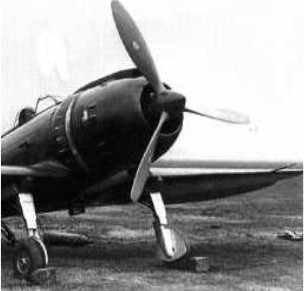
“Reggiane's Ariete plane”
-The engine hood is longer which gives it an even better line, if possible. The aircraft is renamed "Re-2002 Ariete".
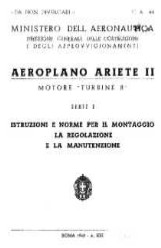
"Aircraft Maintenance Manual"
-Specifically the “Ariete II” with Motore-Turbine B. More information is still being sought.
-Reggiane was located in Reggio Emilia and later it belonged to the Gruppo Caproni and IRI.
-Its main task was manufacturing airplanes but it had a section dedicated to engines.
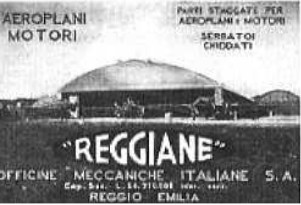
"Advertisement of the time -Aeroplani e Motori-"
-The main production was manufacturing under license the Piaggio P.VIbis, P.VII-C16, C35 and C45, P.XIbis, P.XV and P.XIX-RC45 turbo.
-Under Fiat license they made the A74-RC38 and RA.1050-RC58 Tifone.
-During the stay of the Germans in Italy (WWII) and through the entity that they founded called CARIM, they made components and assemblies to manufacture German engines (with Isotta Fraschini also collaborating in this fact).
-The own designs are the most interesting but unfortunately we still do not have illustrations.
-The Re-102 RC-50/1 gave 1500 CV. It seems that it remained in the prototype phase. It was an inverted 18W.
-The Re-103 RC-40 and another one, the RC-50 neither did make it to mass production. They also were inverted 18Ws.
-The Re-104 RC-48 with 1100 CV appears as a simple project without reaching production. This was a V12 engine.
-The R-105 (or Re-105) RC-100 was an engine that did not reach mass production either. It was the same as the Re-103, but with other superchargers to reach 10 km of altitude.
-There also was a study about a 24 cylinder horizontal-H engine. This only remained in the design phase.
-Another prototype, or project, was an 18-cylinder, possibly a turbocharged W18.

“Aeroplani-Motori de Reggiane ad”
From Appendix 6: In the main text are mentioned the compound powerplants that the Reggiane developed for its Reggiane Re-2005 fighter aircraft which was renamed Re-2005R.
-It can be interpreted as a "compound" motor, but there are variants.
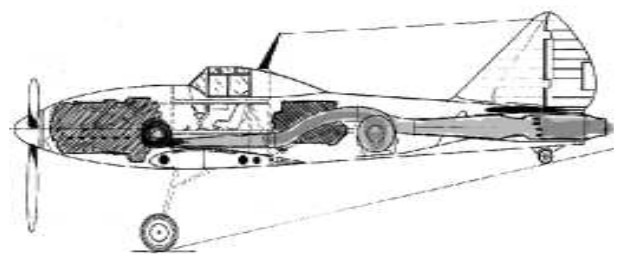
“Reggiane Re-2005R aircraft”
-The main puller engine is a Daimler-Benz DB-605 with its own mechanical supercharger, plus a supercharger that is one of the two compressors located behind the pilot, driven by another Fiat A-20 engine.
-This engine drives the second compressor that sends air to a combustion chamber in the tail of the plane as a “motor-compressor".

“Reggiane Re-2005R, Sarracino”
-The “Sarracino” project remained at that, an unfinished project due to the end of the WWII war. In this case, the main engine drives, through a transmission that runs below the pilot, an axial compressor that feeds a rear combustion chamber.

“Another ad mentioning Aeroplani-Motori Reggiane”
From Appendix 9: A Fiat licenced Reggiane A74RC38 is exhibited at the Trento Museum.
-My collaborator Evzen Vseteka sends me some pictures of this particular engine. See his page <aircraft engines.cz>.

“The Reggiane A74 identified as Fiat”
-The plate is explanatory: It is a Reggiane built under Fiat license.
-The small oval lower plate is simply the one from Fiat after having made an engine overhaul.
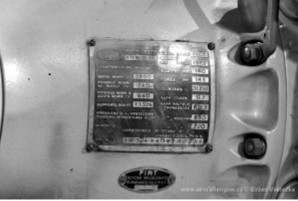
“The mentioned plates”
-These photos are exhibited in another part of this A-Z, they are simply repeated to clarify that it is a Reggiane and not a Fiat.
From Appendix 10: Now, thanks to a fellow AEHS hobbyist, we have a photograph of the Reggiane licensed by Fiat, model A74RC-38/Reg.
-This engine is mentioned in the main text, but it is not accompanied by any illustration.

“The Reggiane engine at a museum”
Re-103 and Re-105 engines are mentioned in the main text without accompanying any illustration. Finally one has appeared in which we already see photographs of them.
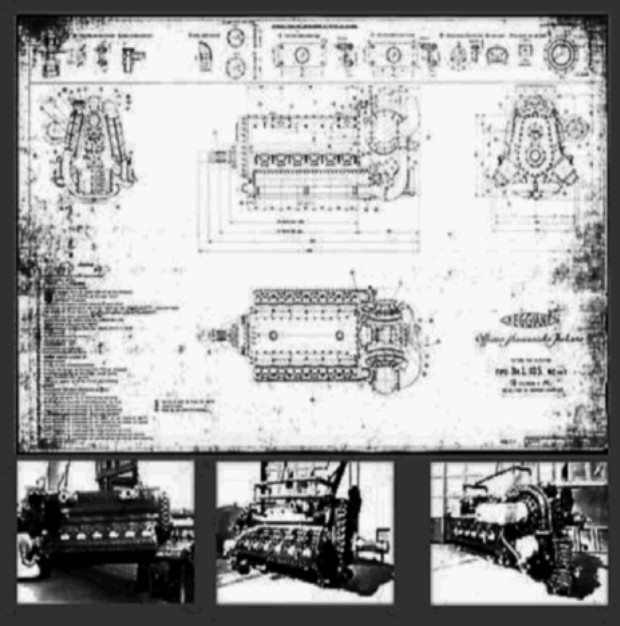
“Reggiane Re 105 document”
-Although it is already mentioned that they are in-line engines and of Reggiane's own design, there is a great resemblance to the German DB engines of the time.
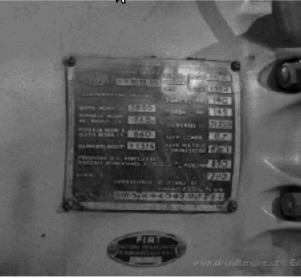
“A74RC-38/Reg. engine plate”
-The information of this brand is expanded with illustrations of engines that it manufactured during WWII. Reggiane was best known as an aircraft manufacturer.
-The Regiane Mechanical Office made engines under license from Fiat, Piaggio and Daimler-Benz.
-The same office and with the accumulated experience made engines of its own design such as the Re-101, Re-102, Re-103 and Re-104.
-The Re-101 was a design from the late 30s, clearly based on a DB-601 with a mechanical compressor and gearbox. It was an inverted V-12.
-The Re-102 was a W-18 engine, that is to say with three rows of 6 cylinders in W, but also inverted. It gave 1,550 CV.
-The same happened with the Re-103. It had 18 cylinders in inverted W as well. The engine was slightly larger than the Re-102.

“Reggiane R-103-RC50/1 on supports”
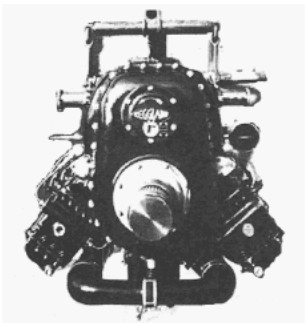
“Reggiane Re-103 (RC-50/I) front view”
-Below, a triptych with four views of Re-103. There is also another photograph with a left side view of the engine. The front one on the right side is mutilated due to the lack of wiring (harness) of the spark plugs.

"Re 103, four drawings"

“Reggiane Re-103 left side view”
-It was intended to give 1,750 hp up to 5,000 meters (Re-103 RC50 / I). There was another version, the RC57 that maintained power up to the critical altitude of 5,700 meters.
-The Re-104 was a project of a V-12 based on the Isotta Fraschini Asso L.121 RC40 and that turned out to be a possible alternative for the DB-601. No prototype has been built.
-The Re-105 was the same as the Re-103, but with two mechanical superchargers that maintained the power of 2,200 hp up to 10,000 in altitude. For this reason, Re-105 RC100 is mentioned as the engine reference.
-The "R" was for the reducer and the "C" for the compressor.
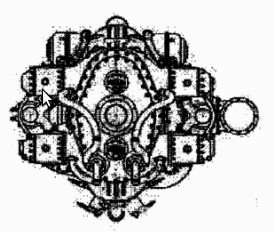
“Reggiane Re-105, front view”

"Re-105 top and side view”
From Appendix 12: New photos of engines made mainly during WWII. Although there are projects that started in 1937.
-The Vortex was started around 1937. With versions of 8 cylinders in V and 12 cylinders in V (Parts of them were used for the development of the Re103.
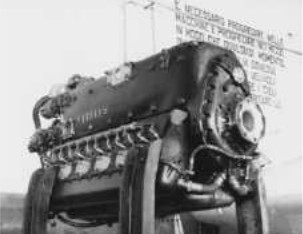
“Re-101, 12-cylinder inverted-V”
-CA-24 air cooled 24 cylinders in X, no further data at the moment.
-Vortex in air-cooled boxer version. (is it the previous one?).
-The Re-101RC50, 12-cylinder inverted V (base DB-601). and 1100 CV. At 5000 meters altitude.
-The Re-102RC50, an 18-cylinder inverted-W, gave 1350 CV at 5,000 meters of altitude.
-The Re-103RC40 also an 18-cylinder, inverted-W gave 1500 CV at 4,000 meters, it had a 2-speed compressor. The Re-103RC50 from 1640 to 5000 meters altitude had a 3-speed compressor.
-For the Re-103 the single cylinder P-40L test engine was made.

“Re-103, 18-cylinder inverted-W”
-The 2T was a diesel engine.
-Another experimental was the 24-cylinder based on the Re-103. From 2200 HP. (Ca-24?) (Or H-24).
-Re-104RC38 of 12 V and 840 CV. It did not go into production. Based on the Asso L121RC40 from Isotta Fraschini. It was to replace the German DB-601s.
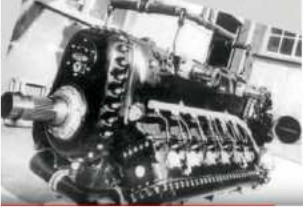
“Another Reggiane 18-cylinder inverted-W engine”
-Re105RC100, 18 W inverted and 1500 hp at 10,000 meters of altitude. Similar to Re-103 with the difference of using a two-stage, 4-speed compressor.
-Of the Re-105 there are two diagrams, one seen from behind showing the two compressors in an angle and the other one seen from the top with the two compressors clearly visible.

“Re-105, rear view”

“Re-105, top view”
-The H-24 project was actually a twin boxer engine, placed one on top of the other and with cylinder blocks from the Re-103.

“H-24 side view”
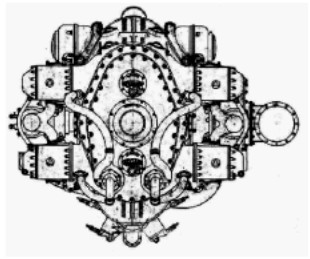
“H-24, front view”
-Taking advantage of the opening of this Reggiane appendix to expose a picture of the Reggiane 2007 airplane of which the Americans took 70% of the project to the US on October 12, 1944 and of which there is no doubt that it is the "father" of the North-American F-84 "Sabre"
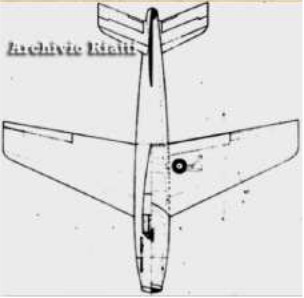
"There is no doubt about inspiration" (Arch. Riatti)
-For the Re-2007, the Italians had already received a Junkers Jumo-004 from Germany.
Engines of REGGIANE
Model: 2-stroke diesel
Arquitecture:
Cooling:
Total Displacement:
Bore / Stroke: x
Power:
Weight:
Model: CA-24 X24 aire
Arquitecture:
Cooling:
Total Displacement:
Bore / Stroke: x
Power:
Weight:
Model: DB-601 (Lic.)
Arquitecture:
Cooling:
Total Displacement:
Bore / Stroke: x
Power:
Weight:
Model: DB-605 (Lic.)
Arquitecture:
Cooling:
Total Displacement:
Bore / Stroke: x
Power:
Weight:
Model: Fiat A74-RC38 (Lic.)
Arquitecture:
Cooling:
Total Displacement:
Bore / Stroke: x
Power:
Weight:
Model: P40L, 1 cyl. de estudio
Arquitecture:
Cooling:
Total Displacement:
Bore / Stroke: x
Power:
Weight:
Model: Piaggio P.VI, VII, IX, XI bis, XV (Lic.)
Arquitecture:
Cooling:
Total Displacement:
Bore / Stroke: x
Power:
Weight:
Model: RA-1050 “Tifone” (Lic. Fiat RA-1050 Tifone)
Arquitecture:
Cooling:
Total Displacement:
Bore / Stroke: x
Power:
Weight:
Model: Re-101RC - 12V
Arquitecture:
Cooling:
Total Displacement:
Bore / Stroke: x
Power:
Weight:
Model: Re-102RC - 18W
Arquitecture:
Cooling:
Total Displacement:
Bore / Stroke: x
Power:
Weight:
Model: Re-103RC - 18W
Arquitecture:
Cooling:
Total Displacement:
Bore / Stroke: x
Power:
Weight:
Model: Re-104RC - 12V (ex Alfa Romeo L121RC40)
Arquitecture:
Cooling:
Total Displacement:
Bore / Stroke: x
Power:
Weight:
Model: Re-105RC - 24H Vortex
Arquitecture:
Cooling:
Total Displacement:
Bore / Stroke: x
Power:
Weight:
Model: Super Vortex XII, 12 cyl.
Arquitecture:
Cooling:
Total Displacement:
Bore / Stroke: x
Power:
Weight:


